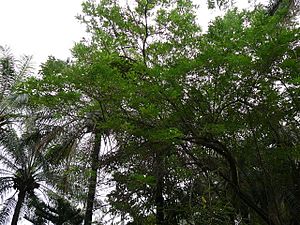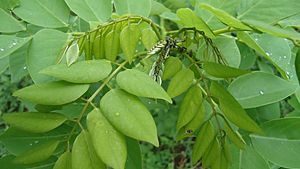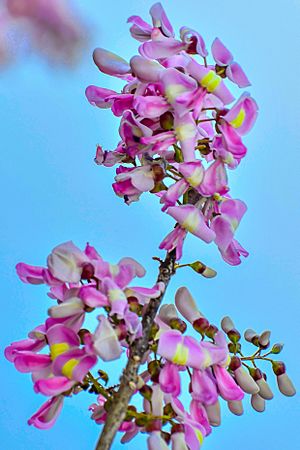Quickstick facts for kids
Quick facts for kids Quickstick |
|
|---|---|
 |
|
 |
|
| Scientific classification | |
| Genus: |
Gliricidia
|
| Species: |
sepium
|
| Synonyms | |
|
|
Gliricidia sepium, also known as Gliricidia, is a medium-sized tree. It belongs to the Fabaceae family, which includes many plants that produce pods, like peas and beans. This tree is very useful and grows in many tropical areas.
People call it by different names around the world. Some common names are quickstick, mata ratón, madre cacao, and kakawate. It is originally from places like Mexico and Colombia. Now, you can find it in many other warm parts of the world.
Contents
About the Gliricidia Tree
The Gliricidia sepium is a tree that can grow quite tall. It usually reaches about 10 to 12 meters (33 to 39 feet) high. Its bark is smooth and can be whitish-gray or a deep reddish-brown.
The flowers grow at the ends of branches that don't have leaves. They are a pretty pink or lilac color, often with a touch of white. You might also see a pale yellow spot at the bottom of each flower.
The fruit of the tree is a pod, which is like a long, flat seed case. These pods are about 10 to 15 centimeters (4 to 6 inches) long. They start green and turn yellow-brown when they are ready. Each pod holds four to ten round, brown seeds.
Where Gliricidia Grows
This tree naturally grows in the tropical dry forests of Mexico and Central America. But people have planted it in many other warm places. This includes the Caribbean, parts of South America, Central Africa, India, Sri Lanka, Myanmar, and Southeast Asia.
The Gliricidia tree can grow well in slightly acidic soils. It is often found in volcanic soils where it naturally grows. However, it can also thrive in sandy, clay, or limestone soils.
Uses of Gliricidia
The Gliricidia sepium tree is used for many different things. It was first spread to other countries to provide shade for crops like coffee. Today, it helps farmers in many ways.
- Live Fencing: People plant Gliricidia trees close together to create living fences. These fences help protect farms and orchards from animals like goats and cows.
- Animal Food: The leaves of Gliricidia are used as food for animals like cattle, sheep, and goats. They are full of protein, which helps animals stay healthy, especially when other food is scarce.
- Firewood: The wood from Gliricidia trees can be used for burning as firewood.
- Green Manure: Farmers use its leaves and branches to enrich the soil. This is called "green manure" and helps crops grow better.
- Intercropping: It is planted among other crops to help them grow.
- Rat Poison: Parts of the tree have been used traditionally to make poison for mice and rats.
Gliricidia as Animal Fodder
Gliricidia sepium is a great food source for farm animals. Farmers can cut its branches and feed them to cattle, sheep, and goats. It has a lot of protein, which is important when other animal foods are not very nutritious.
This tree can be cut many times, usually every 2 to 4 months. Even when cut, it keeps its leaves during the dry season. This is a big help when other plants have lost their leaves and there's not much food for animals. Sometimes, it's the only food source available during dry times.
Helping Crops Grow (Intercropping)
Gliricidia sepium trees are often planted between other crops. This is because they help add nitrogen to the soil. Nitrogen is a key nutrient that plants need to grow. By adding nitrogen, Gliricidia can make crop yields much better without needing a lot of chemical fertilizers.
These trees can be cut back to the height of the crops. They can even be cut down to the stump, and they will grow back. When they are cut, their roots temporarily stop competing for nutrients. This allows the main crops to grow strong. These qualities also make Gliricidia good for use as green manure.
Stopping Soil Erosion
Gliricidia sepium grows very fast. It is often planted to help stop soil erosion on bare land. Because it's easy to plant and grows quickly, it's used to protect the topsoil. It's a good first step before planting slower-growing trees to bring back a forest.
Shade for Other Plants
The name madre de cacao means "mother of cacao" in Spanish. This name comes from its traditional use. Farmers in Central America and the Philippines used Gliricidia trees to provide shade for their cocoa tree plantations.
Other Uses
Gliricidia sepium is also used to keep insects away. Farmers in Latin America sometimes wash their animals with a paste made from crushed Gliricidia leaves. This helps to protect the animals from botflies. In the Philippines, an extract from its leaves is used to make a special shampoo for dogs with skin problems.
Things to Know About Gliricidia
While Gliricidia is very useful, there are a few things to be aware of.
Toxicity
The name Gliricidia actually means "mouse killer." This is because the seeds and bark of the tree are toxic. They have been traditionally used to make poisons for rodents. Because of this, the tree seems to be harmful to animals that are not ruminants (animals like cows that chew their cud).
Taste and Smell
Sometimes, animals might not want to eat the leaves of Gliricidia. This can depend on how the leaves are prepared or where the tree grows. Animals might refuse them because of their smell.
Growing Conditions
Gliricidia is a tropical plant, so it doesn't do well in cold weather. It cannot handle frost.
For the tree to produce seeds, it needs pollinators (like bees). However, it is often grown from stem cuttings. These cuttings tend to grow shallow roots. The seeds themselves are hard and smooth. They need to be scratched a little (like with sandpaper) to help them take in water and germinate (start growing).
Invasive Potential
Because Gliricidia grows so quickly and easily, it can sometimes spread too much. In places like Jamaica, it is even considered a weed because it can take over areas.
Pests and Diseases
So far, Gliricidia sepium has not had many serious diseases. There have been some insect problems in places where it's not native. For example, in April 2023, the Black bean bug (Brachyplatys subaeneus) was seen infesting these plants on the island of Montserrat.
Names in Other Languages
| Language | Name |
|---|---|
| Marathi | गिरीपुष्प, ऊंदीरमारी, खताचे-झाड |
| Konkani | सारया झाड |
| Kannada | ಗೊಬ್ಬರದ ಗಿಡ |
| Malayalam | ശീമക്കൊന്ന,പത്തല്, സെമ്മക്കൊന്ന |
| Tamil | சீமை அகத்தி |
| Tulu | ಈಟ್ದ ಮರ |
| Sinhala | වැටහිරියා, ගිනිසීරියා, ලාඩාප්ප, මකුලත,ඇල්බීසියා,වැටහිර, ලංචි |
| Thai | แคฝรั่ง |
| Myanmar | ပဲချယ်ရီ၊ အညာချယ်ရီ၊ ကြွက်သေပင်၊ သင်္ဘောငုစပ် |
In Indonesian, Gliricidia sepium is known as gamal. This name is an acronym for Ganjang Malaysia, which means "Down with Malaysia."
See also
 In Spanish: Cacahuananche para niños
In Spanish: Cacahuananche para niños


